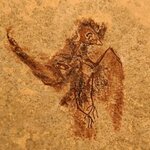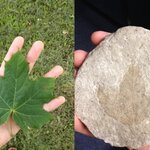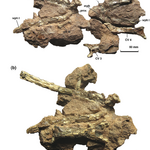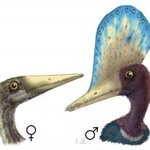Paleontology

Why did saber-toothed cats, hyenas, an extinct 'bear-dog', ancestors of the red panda and several other carnivores die under unusual circumstances in a Spanish cave near Madrid approximately 10 million years ago?
Different scenarios have been floated for why an unusually large concentration of healthy adult carnivores died in this cave during the Late Miocene, a location known now as Batallones-1 fossil site, Madrid Basin, Spain; accidental falls into the cave, maybe the animals died in other locations and were washed into the cave, everything but mass suicide.
Yet those scenarios…

A tiny fossil, the nearly complete skeleton of a bird that would have fit in the palm of your hand and weighed less than an ounce, offers clues to the precursors of swift and hummingbird wings. The fossil
discovered in Wyoming
is unusual in having exceptionally well-preserved feathers, which allowed the researchers to reconstruct the size and shape of the bird's wings in ways not possible with bones alone.
The paleontologists spotted the specimen, which was collected at the Green River Formation, while they were working at the Field Museum of Natural History in Chicago and named it…

Evolution is misunderstood by millions. And, it has to be said, a lot of the time, this problem isn't helped by the way things are reported on the TV or in the news.These are the 5 most common terms that, when I hear them used, I die a little. Though their effect is subtle, all of these terms perpetrate common myths about the way evolution works. The sooner they become extinct, the better!
1. Survival of the FittestNow, this term is something that often gets used synonymously with natural selection. In fact, it wasn't actually coined by Darwin himself; it was first used by Herbert…

An unusual fossil of Euphanerops, a fossil jawless fish that swam in the seas around 370 million years ago, has fins behind its anus - a pair of them. The find makes the fish one of the first vertebrate to develop paired appendages such as fins, legs or arms.
However, their positioning is the interesting part.
"Euphanerops is unique because its anal fin is paired meaning there is one fin on each side of the fish. Up until now anal fins have only been seen on jawed fish where they are unpaired and this is true of both extinct and modern fish. The age of Euphanerops is important as…

In a first, a whale skeleton has been found on the ocean floor near Antarctica, almost a mile below the surface in an undersea crater. With it were at least nine new species of deep-sea organisms thriving on the bones.
When a whale dies and sinks to the ocean floor, scavengers quickly strip its flesh. Over time, other organisms then colonise the skeleton and gradually use up its remaining nutrients. Bacteria break down the fats stored in whale bones, for example, and in turn provide food for other marine life. Other animals commonly known as zombie worms can also digest whale bone.…

A study has documented detailed records of dinosaur egg fossils in the Coll de Nargó archaeological site in Lleida, Spain and found there are four. Up until now, only one type of dinosaur egg had been documented in the region.
The archaeological site in Coll de Nargó is home to different types of geological formations, including the Areniscas de Arén Formation and the Tremp Formation, which have provided a rich and varied yield of dinosaur fossils through the entire Pyrenees region.
"Eggshells, eggs and nests were found in abundance and they all belong to dinosaurs, sauropods in…

The first evidence for an extinct giant camel in Canada's High Arctic has been revealed. The discovery is based on 30 fossil fragments of a leg bone found on Ellesmere Island, Nunavut and represents the most northerly record for early camels, whose ancestors are known to have originated in North America some 45 million years ago.
The fossils were collected over three summer field seasons (2006, 2008 and 2010) and are about three-and-a-half million years old, dating from the mid-Pliocene Epoch. Other fossil finds at the site suggest this High Arctic camel lived in a boreal-type forest…

Remarkably well-preserved fossils of two crocodilians and a mammal previously unknown to science during recent Panama Canal excavations have led to discovering of new species.
The two new ancient, extinct alligator-like animals and an extinct hippo-like species inhabited Central America during the Miocene about 20 million years ago. The fossils shed new light on scientists' understanding of species distribution because they represent a time before the formation of the Isthmus of Panama, when the continents of North and South America were separated by oceanic waters.
"In part we are…

A new kind of pterosaur named Eurazhdarcho langendorfensis was a flying reptile from the time of the dinosaurs, according to scientists from the Transylvanian Museum Society in Romania, the University of Southampton in the UK and the Museau Nacional in Rio de Janiero, Brazil.
The fossilized bones come from the Late Cretaceous rocks of Sebeş-Glod in the Transylvanian Basin, Romania, which are approximately 68 million years old. The Transylvanian Basin is known for its many Late Cretaceous fossils, including dinosaurs of many kinds, as well as fossilized mammals, turtles, lizards and…

Sexual selection refers to the evolutionary pressures that relate to a species' ability to repel rivals, gather mates and pass on genes. We can observe those processes happening in living animals and, now, detecting sexual selection in the fossil record is also possible, according to researchers.
It has been challenging to recognize sexual selection in extinct animals. Many fossil animals have elaborate crests, horns, frills and other structures that look like they were used in sexual display but it can be difficult to distinguish these structures from those that might play a role in…